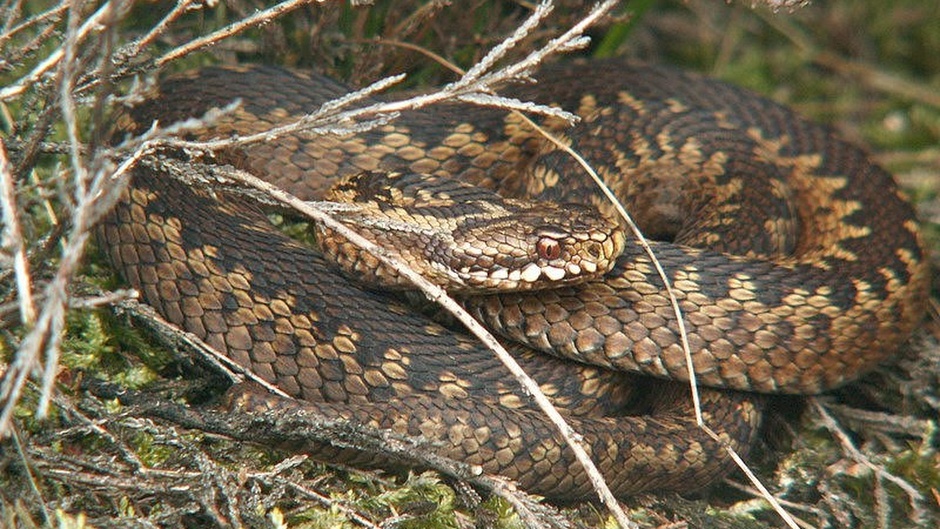The viper that bit Paul
In Israel there are currently seven species of vipers. In the Old Testament there are numerous Hebrew terms that refer to them.
12 JUNE 2022 · 11:00 CET

When Paul had gathered a bundle of sticks and put them on the fire, a viper came out because of the heat and fastened on his hand. When the native people saw the creature hanging from his hand, they said to one another, “No doubt this man is a murderer. Though he has escaped from the sea, Justice has not allowed him to live.” He, however, shook off the creature into the fire and suffered no harm. They were waiting for him to swell up or suddenly fall down dead. But when they had waited a long time and saw no misfortune come to him, they changed their minds and said that he was a god. (Acts 28:3-6)
The common term “viper” is used to refer to poisonous snakes belonging to the Viperidae family.
In Israel there are currently seven species of vipers, whose names in Hebrew are: Tzefa Matzui (Daboia palaestinae), Tzefa Hermon (Montivipera bornmuelleri), Eh’phe’eh (Echis coloratus terraesanctae), Achan Katan (Cerastes vipera), Achan Gadol (Cerastes gasperettii mendelsshni), Achan Hartumim (Cerastes cerastes) and Shefifon (Pseudocerastes fieldi). [1] All of them are venomous and therefore dangerous for the human being, especially when crossing desert terrains.
With this diversity of poisonous snakes, and there are in Israel other families of venomous snakes, in the Old Testament there are numerous Hebrew terms that refer to them. Among these the following particularly stand out: shephiphón, which means “dragger” and, according to scholars, it could refer to the horned viper (Cerastes cerastes) which habitually leaps at its victim in order to bite (Genesis 49:17); epheeh, which means “whistler” and appears in the books of Job and Isaiah (Job 20:16; Is. 30:6; 59:5), although it is not known exactly which species this refers to; another term used for poisonous snakes is pethen (Dt. 32:33; Psalm 58:4; 91:13; Job 20:14, 16; Is.11:8); the word akhshub, which was translated as “asp”, only appears once. In verse 3 of Psalm 140: “They make their tongue sharp as a serpent's, and under their lips is the venom of asps.”; and finally, other terms are tsipheoní, (the hissing viper) (Proverbs 23:32; Isaiah 11:8; 59:5; Jer. 8:17); tsepha (Is. 14:29); and the word used in the New Testament for poisonous snake is: ékhidna (Mat. 3:7; 12:34; 23:33; Luke 3:7; Acts 28:3) and also theríon or “dangerous animal” (Acts 28:4-5).
In the Bible, vipers always appear as negative symbols due to the danger posed by their venom. They can bite the heel of a horse and cause its rider to fall (Gen. 49:17). Their poison can break up organic molecules like a molecular scalpel and kill animals and human beings (Job 20:16). However, this evil, along with that of the whole of the natural world insofar as it is subjected to evil forces, will end definitively when the new shoot sprouts out of Jesse’s stump and the weaned child extends his hand over the viper’s nest (Isaiah 11:8). These reptiles inhabit the Negev desert (Isaiah 30:6), but Jesus compares them to some of the Pharisees and Sadducees in Jerusalem (Matt. 3:7; 12:34; 23:33; Luke 3:7). The New Testament also shows how the final eradication of evil is anticipated in the lived experience of the disciples and apostles. It was the power of God that saved Paul from the poison of the viper that bit him on the island of Malta, and which was probably a European species (Acts 28:3-6).
Now there are no more snakes on the island of Malta because, as in other relatively small islands, they were got rid of by human settlers. This was aided and abetted by the introduction of predators like domesticated cats. However, at the time the apostle Paul was there, there were many of them, as can be observed in the Biblical text. What is curious about this story (in Acts 28: 1-10) is the response of the islanders. According to pagan superstition, Paul must have been guilty of homicide or some other heinous sin, as everything seemed to be going wrong for him. First his trial and conviction and being sent to Rome, then the storm at sea which almost finished off the crew of the ship, and finally his being attacked by a viper. However, when they saw that the viper’s poison had no effect, they radically changed their minds and said that he must be a god.
Well, neither was true. When bad things happen, it is not always because we are being punished by God, and likewise, positive outcomes and prosperity are not necessarily a sign of God’s blessing and approval. If God had to punish us or reward us for our actions, we would all be on the road to hell. However, it is only the power of God, through faith in Christ, that can bring about salvation (1 Peter 1:5).
Notes
[1] Bar, A. & Haimovitch, G. 2011, A Field Guide to Reptiles and Amphibians of Israel, Herzliya, Israel, pp. 188-201.
Published in: Evangelical Focus - Zoe - The viper that bit Paul
